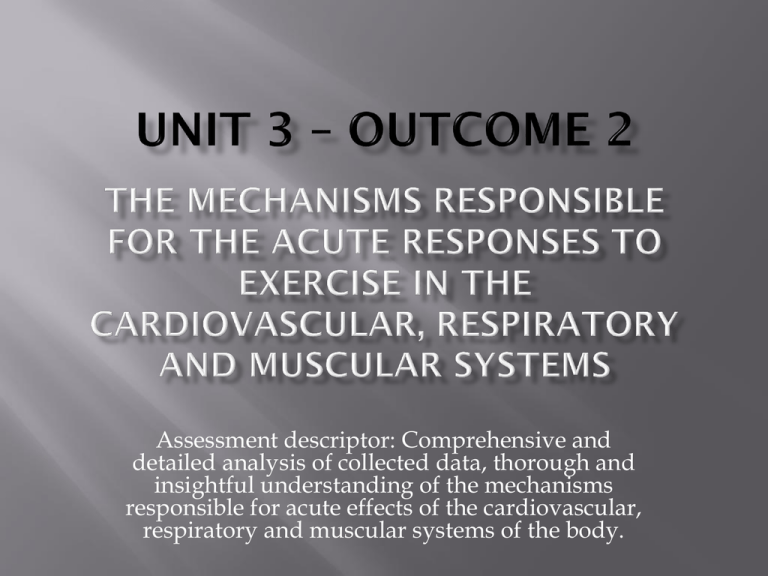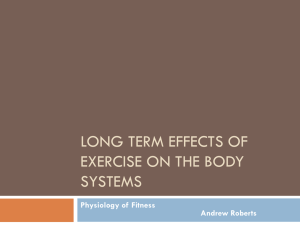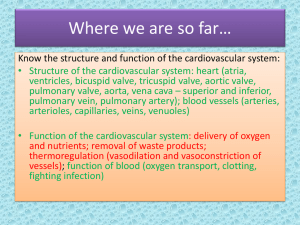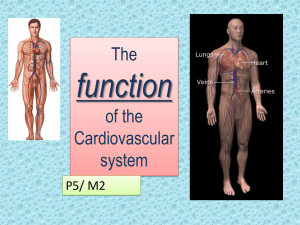Acute Cardiovascular Responses to Exercise
advertisement

Assessment descriptor: Comprehensive and detailed analysis of collected data, thorough and insightful understanding of the mechanisms responsible for acute effects of the cardiovascular, respiratory and muscular systems of the body. Heart Blood vessels Blood The CV system regulates the delivery of 02 and fuel to the body cells. As we begin exercising the CV system assists us to meet the additional demands that the exercise is placing on the body. They assist to deliver more 02 to the working muscles. They also assist to remove more CO2 and other waste products HR Blood flow SV AV02 diff Q BP HR is the simplest measure to gauge how hard the CV system is working – it measures the hearts function. Measured in beats per minute - bpm There is a direct link between HR and exercise intensity. HR can be affected by variables such as fatigue, hydration, ambient temp, illness, and altitude. Resting HR ranges from 60 to 82bpm! However, endurance athletes have HR’s recorded as low as 28bpm. Lance Armstrong’s resting HR is 32-34 with a MaxHR of 201!!!! WOW!!! Just before beginning exercise you often get an increase in HR – this is as a result as anticipating the exercise. This occurs because of a release of hormones such as epinephrine (adrenaline). HR will increase linearly with exercise intensity, so as exercise intensity gets harder heart rate will increase. This continues until a person reaches their max HR (MaxHR) and then it will plateau (even if exercise intensity continues to increase) We use this MaxHR to set athlete’s training zones. The general rule for working out a person’s max HR is MaxHR = 220 - age For example a 20 year old will have a MaxHR of 220-20 = 200bpm This is only an estimate and is based on MaxHR slowly declining with age. HR will vary for each individual HR is controlled by the parasympathetic and sympathetic nervous system as well as the endocrine system. We have no conscious control over the parasympathetic nervous system This system originates in the brain stem and extends to the heart via the vagus nerve At rest it the parasympathetic NS is dominant – when HR is less than 100bpm Is the opposite side of the autonomic sympathetic nervous system It has the opposite effect of the parasympathetic NS It stimulates the heart causing an increase in HR and an increase in the force of contractions It is dominant when HR is over 100bpm Conditions SV (mL/beat) HR (beats/min) Cardiac Output (L/min) Untrained Rest 75 82 6.2 Untrained Max exercise 112 200 22.4 Trained Rest 105 58 6.1 Trained Max exercise 126 192 24.2 Stroke volume is the amount of blood ejected from the left ventricle of the heart per beat Stroke volume will increase with exercise to assist meet the increased energy demands Stroke volume is controlled during exercise by: Volume of venous blood return Capacity of the ventricle to expand (distensibility) Capacity of the ventricle to contract (contractility) The pressure the ventricles have to contract against Untrained athlete Trained athlete SV at rest 60-75ml/beat SV during max exercise – 80-115ml/beat SV at rest 80-110ml/beat SV during max exercise – 160-200ml/beat Stroke volume will reach its maximum value between 40-60% of a person’s VO2 max. Conditions SV (mL/beat) HR (beats/min) Cardiac Output (L/min) Untrained Rest 75 82 6.2 Untrained Max exercise 112 200 22.4 Trained Rest 105 58 6.1 Trained Max exercise 126 192 24.2 Why do you think a trained athlete has a larger SV then an untrained athlete Why do you think the trained athlete has a lower resting HR? Why do you think the trained athlete has a lower HR whilst exercising? There are 3 main factors that account for the increase in SV during exercise How much the ventricle fills and stretches during diastole (relaxation period) Increase in neural stimulation Decrease in peripheral resistance as a result of vasodilation of the vessels supplying blood to the exercising muscles. This decrease means it is easier for the heart to empty blood from the ventricle and increases SV. During exercise venous blood flow increases This causes the ventricle to stretch more as it fills more fully with blood This results in a more forceful contraction as a result of the greater elastic recall An increased amount of blood in the ventricle results in a stronger contraction of the ventricle, thereby increasing the amount of blood ejected (increased SV) Has the greatest effect at lower intensities At rest, the left ventricle only ejects 40-50% of blood in it. During exercise, the left ventricle ejects more then that Cardiac output = the total volume of blood ejected from the heart per minute Measured in litres per min L/min Q = SV x HR Q(L/min) = SV(mL/beat) x HR (bpm) Cardiac output = stroke volume x heart rate Changes in HR and SV lead to changes in Q. When exercising, both the SV and HR will increase, therefore Q increases At the beginning of exercise and up until approx 60% VO2 max the increase in Q comes from the increase in HR and SV. However, after approx 60% VO2max what causes the increase in Q? SV increases to its max when you are working submaximal (upto 60%), so when you increase intensity, the body compensates by increasing HR, that allows Q to continue to rise Conditions SV (mL/beat) HR (beats/min) Cardiac Output (L/min) Untrained Rest 75 82 6.2 Untrained Max exercise 112 200 22.4 Trained Rest 105 58 6.1 Trained Max exercise 126 192 24.2 Subject SV HR Q REST Untrained male 70 60 100 80 x x x x 72 75 50 55 = = = = 5.0 4.5 5.0 4.4 Trained male 110 90 180 x x x 200 200 190 = = = 22.0 18.0 34.2 Trained female 125 x 190 = 23.8 Untrained female Trained male Trained female MAX EXERCISE Untrained male Untrained female Systolic = the contraction or pumping phase of the heart Diastolic = the relaxation or filling phase of the heart Systolic BP = the pressure in the arteries following contraction of ventricles as blood is pumped out of the heart Diastolic BP = pressure in the arteries when the heart relaxes and the ventricles fill with blood BP increases with exercise During exercise when we are using large muscles groups such as running, swimming and cycling affects the systolic BP more than the diastolic BP During max exercise systolic BP can increase from 120mmHg to 200mmHg Upper body exercises often see a greater increases in BP than lower body exercises Doing resistance activities can cause even greater increases to systolic BP During exercise, arterioles vasodilate (increase in diameter), which means more blood drains from the arterioles into the muscles capillaries. It also means the blood needs to be ejected out of the heart better to cater for this, therefore increase in blood pressure The blood returning to the heart When exercising, Q increases, which means more blood is taken away from the heart, therefore more blood needs to be returned to the heart This occurs in three ways: The muscle pump – muscles constantly contracting squashed veins together, which makes blood travel back to the heart in the ‘smaller’ vein at a more forceful pace The respiratory pump – (similar as above) Breathe in increase abdominal pressure, which pushes blood in veins in thorax and abdomen towards the heart. Breathing out allows pressure to drop and veins to refill. When RR increase due to exercise, this pump increases Vasoconstriction – forces the veins to constrict, which forces blood to be pushed back to heart quicker Blood volume decreases during exercise, especially in the first 5minutes (it then stabilises) The amount of decrease in blood volume is dependant on the intensity of the exercise, environmental factors such as temperature and level of hydration During exercise blood flow redistributes – know as redistributed blood flow A person of average fitness, during max exertion has blood flow greater than water from a kitchen tap! As soon as exercise begins blood flow is redistributed – WHY? To increase the blood flow to the working muscles and a reduction the blood flow to organs This occurs to meet the bodies needs for increased O2 and nutrients and removal of CO2 Redistributed blood flow occurs as a result of vasoconstriction and vasodilation Vasodilation = widening of the blood vessels causing an increase in blood flow Vasoconstriction = narrowing of the blood vessels causing a decrease in blood flow The blood vessels in regions requiring increases in 02 and nutrient delivery vasodilate The blood vessels in regions requiring decreases in 02 and nutrient delivery vasoconstrict These adjustments occur according to intensity Vasodilation occurs with blood vessels near the: Working muscles Vasoconstriction occurs with blood vessels near the: Spleen Kidney Gastrointestinal tract Inactive muscles Heart gets greater supply of blood during exercise, not just more pumped there but the heart muscle itself gets more blood because of vasodilation of the coronary arteries Blood directed at the brain doesn’t decrease by as much This also allows for increases in the surface area of capillaries This increases the area over which gaseous exchange occurs This occurs because we need to increase blood supply up to 20 times greater than rest and this can not be achieved by Q alone Blood flow to the skin increase as it needs to assist in the regulations of body temperature through heat exchange with the environment As exercise intensity increases, blood flow to the skin also increases VO2 is the volume of O2 that can be taken up and used by the body As intensity increases, so does O2 consumption (we know this occurs because ventilation and cardiac output increase. A-VO2 difference also increase A-VO2 diff is the measure of the difference in the concentration of O2 in the arterial blood and the concentration of oxygen in the venous blood Measured in millilitres per 100millilitres of blood At rest our a-VO2 diff is approx 5mL per 100mL – arteries contain approx 20mL/100mL and the veins carry approx 15mL/100mL About 25% of 02 is extracted from the arterial blood by the working muscles at rest. The other 75% goes back to the heart in venous blood During exercise that increases to approx 75% of available 02 is extracted – up to 1518mL/100mL








